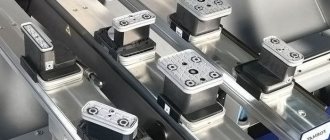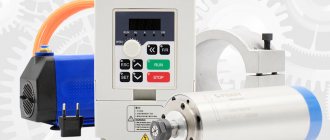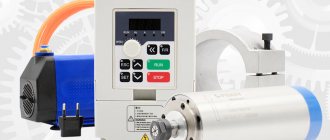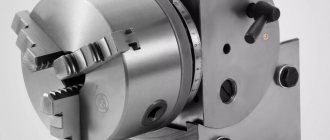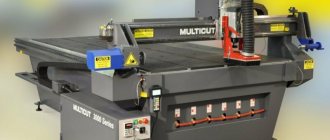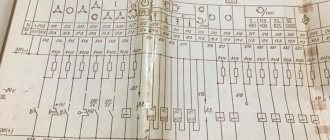Milling machines are used for various technological operations: drilling, countersinking, cutting grooves, recesses of various shapes, processing the ends of parts. To prevent the workpiece from flying to the side, you need to provide a reliable holding system. Clamps for a milling machine are a necessary element that must be installed on any equipment.
Clamp on a milling machine
Purpose
Clamps are used to work with drilling, turning, milling machines. With their help, workpieces are placed motionless on the equipment work table so that they can be conveniently processed from different sides.
The frame of modern equipment has a series of holes that are designed to secure one side of the clamp.
It is most convenient to use a classic vice on drilling machines. They are often installed on the desktop of the equipment by the manufacturer. The vice does not interfere with the movement of the drill and ensures a stable position of the workpiece.
Types of clamping devices for a milling machine
High-quality machining of parts directly depends on the performance characteristics of the clamp. When drilling or boring metal elements, a vice is used. Instead, it is very convenient to use special fastening components - clamping strips with a thrust screw.
On the modern market of building materials and tools you can find a large number of fasteners and sets of clamps for milling machines and other units:
Used for low-profile clamping of workpieces on the milling machine table
- clamps: universal, stepped, curved, fork-shaped, movable;
- supports and struts;
- corners;
- stops;
- fastening kits for various numbers of elements;
- sets of plates and angles.
The fastening set is used in cases where the machine vice is unable to grip a complex structure. The set contains additional fastening devices that allow you to grip: studs, supports, angles, nuts of different lengths, clamps with a corrugated surface.
A set of plates and squares is used if it is necessary to fine-tune and secure an object on the working surface of the machine.
Universal unlined clamp
If it is necessary to secure a part on the machine table, use a clamping bar and supplement it with a support. A screw stop or a lining is used as a support. The design ensures quick and reliable fastening of material on the table of a milling machine and other processing machines. The device looks like this: T-bolt, stand, strip, locking washer.
First, the clamping mechanism is assembled, then it is installed on the frame of the processing machine and brought to the working element. The screw rests against the bar, the body is turned around its axis and secured.
C-shaped clamp
The device does not have a lining; using a hinged joint, the mechanism can be installed at the required height. To quickly adjust the height of the device, the fixing nut is made of two halves, onto which a special ring is placed. If necessary, the ring is removed, the nut is set to the desired height, and the ring is put on. The nut rotates and moves along the threads of the bolt, thereby securing the structure.
Quick release clamp
Designed to secure the part on the bed of a processing machine. The basis of the design is a lever-spring mechanism. The package includes:
Scheme of operation of the high-speed clamp
- rack;
- toothed strip;
- spring;
- clamp body.
In the upper part of the clamping device there is a spring, under it there is a gear rack with a handle. This simple mechanism quickly fixes the body of the clamping unit, allowing it to move along the entire height of the rack.
This design helps reduce setup time and subsequent operations with the element being processed on the machine.
Comb clamping mechanism
Has a durable plastic housing, used for milling machines and circular saws. Each tooth of the comb clamp has a precise shape, which ensures a tight and optimal clamping of the part. The fastening system allows you to combine fasteners with any equipment without additional devices.
The composite teeth of the clamping unit are positioned at a slight angle, which creates pressure on the workpiece from above and on the sides, without leaving any damage to the workpiece during operations on the machine.
Using a clamp
So that when processing the workpiece, the chips are carefully removed and the edge of the cutting tool is visible, the material being processed is placed at a distance of 2.5 centimeters from the edge of the milling table. The result is achieved by adding lining material, each element of which has the same thickness.
Clamp
A clamp is a cylindrical object, inside of which a clamping device and a pin are placed. A spring presses on the device from the bottom, which helps to hold the structure in the upper position.
On the body of the clamp, side slots are visible, which serve as places for attaching the object to be processed. The device allows you to securely fasten parts with a thickness of no more than 3 centimeters.
A clamp is an auxiliary tool with which spare parts are secured to a milling machine and other machines for further processing. With little effort, the clamp creates the necessary force to securely fasten the part. There are several types of clamps that provide clamping of the product:
- F-shaped - work with large-sized parts;
- G-shaped ones are used when it is necessary to secure a small object. This is the most common type of clamp, made of cast metal or cast iron;
- the pipe type is designed to exert significant pressure on the components being processed;
- The corner clamp is capable of connecting parts at an angle.
Varieties
There are several types of milling clamps:
- Universal unlined. It is a clamping bar that must be supplemented with support. If there is no screw support, a backing is used. In appearance, it is a T-shaped bolt, which is threaded through a stand with a bar, clamped with a washer. This instrument is sold disassembled.
- Comb mechanism. It has several clamping teeth that are located at certain angles. This allows you to hold the workpiece more securely, preventing it from slipping due to vibrations. The pressure is distributed not only over the top of the workpiece, but also along its sides.
- C-shaped. There is a metal ring on the clamping bolt that increases the pressure area. If desired, you can remove it and remove the bolt. The main advantages are simplicity of design, ease of operation, reliability, and durability.
- Fast-acting mechanisms. The operating principle is based on a lever-spring system. Additional elements are the tool body, a bar with teeth, a spring, and a stand.
- Cam clamp kit. Represents 5 monolithic devices. Each of the cams has two working surfaces. They are secured with bolts and crackers.
The operating principle of the clamps does not change depending on their type. There are several types of clamps:
- Pipe - designed to create powerful pressure when connecting materials. Can be made of cast iron.
- F-shaped - suitable for working with large workpieces.
- Corner - allow you to set an angle and fix it motionless.
- G-shaped - used for fastening small parts.
The choice of equipment depends on the size of the workpiece being processed. Modern clamps have a special hook with which you can quickly release the pressure and change the setting.
There are also special mounting kits. They will be needed in cases where it is necessary to process a part of complex shape, and it is impossible to hold it with ordinary clamps.
For high-precision fixing of the workpiece, sets of angles and plates of different thicknesses are used. They play the role of linings when it is necessary to set the level down to millimeters.
There is equipment that is installed by milling machine manufacturers themselves. Kinds:
- Screw spacers, angles.
- Step clamps.
- Tile stops.
- Fork-shaped clamps that slide along guides.
- Trough-shaped vice.
- Universal clamps with a curved shape.
When choosing a machine, you need to inquire about the availability of clamps and their type.
Purpose of clamps for a milling machine
Clamping devices are used in drilling, milling and lathes to fix workpieces on the bed, and are necessarily included in the set of tools that equip the equipment. They are able to secure the product so that it can be processed conveniently from any side. Replacing clamping devices with simple yews will not bring the long-awaited result, due to the frequent inability to properly fix the part.
Clamp KREG KMS7511 for milling machine
On the bed of processing machines there are special openings in which milling clamps are bolted. The bolts have special heads that prevent the bolt body from turning and make the connection especially strong.
To achieve a high level of product processing, clamping devices are classified by type of clamp. One clamp installed on the machine is capable of ensuring the accuracy of adjustment associated with numerous transitions when working with different types of parts.
Clamps for milling machines, drilling and other types of equipment must ensure quick and rigid fastening of the workpiece on the side required for work, height adjustment, and free access of the cutting tool to the product. The workpieces processed must meet the following requirements:
- exact location of the material;
- reliable fixation of the part;
- The body of the product allows you to conveniently install clamping devices.
All types of clamping mechanisms must have a high degree of strength and not be deformed under the influence of a screw clamp. Otherwise, the element being processed may jump out and cause harm to the equipment and human health.
The clamping device must hold the part tightly so as not to harm your health while working on the milling machine.
Selection principles
When choosing additional equipment, you need to pay attention to the following factors:
- Dimensions, weight.
- Stroke range of the pressing part.
- The material from which the stand is made.
- Clamping mechanism.
It is advisable to buy cast metal clamps to get a reliable hold of the workpiece. It will last longer than the plastic one and will make it possible to clamp with greater force.
Advantages and disadvantages
Clamps have several strengths:
- Can be installed in any location.
- They can be useful around the house for various purposes.
- Provides reliable holding of workpieces.
Manufacturers and cost
Manufacturers:
- Bessey - 1500 rubles.
- STANLEY - 1000 rubles.
- WOLFCRAFT - 1300 rubles.
- GROSS - 1000 rubles.
- STAYER - 700 rubles.
The cost depends on the type of clamp, its size, and the material from which it is made.
Making your own pressing machine
To make a clamping mechanism yourself, you should carefully observe the operation of factory models. The fastener, after its manufacture and installation on the machine, must have the following functional features:
- achieving smooth adjustment of the clamping of the object, the pressure on the product should be evenly distributed over the entire surface;
- when operating the machine, the device must not damage the workpiece (scratch, deform);
- The technical characteristics of the device must correspond to safe operating conditions.
DIY eccentric clamp drawing
First manufacturing option:
- The basis of the clamp is ordinary rollers for squeezing clothes from an old washing machine;
- a frame with four guides is prepared, which are connected by a U-shaped profile;
- the shafts are mounted on the profile and fixed with an adjusting bar in the upper part.
This model is bulky and uncomfortable, but quite effective. To reduce the size of the structure, the rollers can be trimmed.
Manufacturing carpentry clamps for pressing parts on a milling machine
Second build option:
- slats are installed on both sides of the frame;
- take two bearings and place them on the working shaft;
- the degree of fixation of the part is adjusted using a spring that moves freely along the slats;
- The clamp design helps to process the material without pre-setting.
After installing a homemade clamp on a milling or other processing machine, the operational and technical characteristics of the equipment should not become worse.
